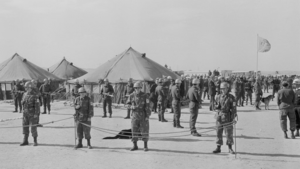What's the 'Land-for-Peace Principle' the US Wants the UN Court to Use?

The U.S. wants the UN court to use a land for peace framework to resolve Israeli-Palestinian conflict in the Middle East.
In short: The U.S. testified at the United Nations’ court on Feb. 21, saying that Israel should not be “legally obligated to immediately and unconditionally withdraw” from occupied Palestinian territory. Instead, they said the International Court of Justice should work within the “land-for-peace” framework when issuing their legally nonbinding opinion. The “land-for-peace” principle grew out of a set of U.N. resolutions from the mid-20th century, and it asserts that, if Israel withdraws from the territory it occupies, the surrounding Arab countries will recognize Israel as a sovereign nation, leading to peace in the region.
What did the U.S. say at the ICJ's hearing on Israel's occupation?
The U.N. General Assembly approved a resolution at the end of December 2022 that condemned Israel’s behavior in the Palestinian territories and asked the ICJ, the U.N.’s main judicial body, to issue an advisory opinion on the legality of Israel’s decades-long occupation of the territories.
After several months of preliminary written arguments, the ICJ began oral proceedings in the case on Feb. 19. During these hearings, which are expected to last about a week, representatives of 52 countries and three international organizations are making statements to the court about how they think it should rule.
The U.S. testified to the court on Feb. 21, saying that the ICJ should not try to “resolve” the conflict by issuing a broad advisory opinion, but instead use the land-for-peace framework to issue an advisory ruling that will “support and promote final realization of peace and stability,” which the U.S. believes is best accomplished through a two-state solution.
After oral proceedings conclude on Feb. 26, the court will begin its deliberation on whether they believe Israel’s occupation of the Palestinian territories is in breach of international law.
What is the land-for-peace principle?
At the center of the land-for-peace principle is the idea that, should Israel withdraw from the territory it occupies, peace will be made by the surrounding Arab countries in return.

Israeli soldiers stand at the destroyed bridge at Geneffa, looking over the Egyptian bank of the Suez Canal, June 1967.
According to the U.N. Economic and Social Commission for Western Asia, “The issue of land is at the core of the Palestinian-Israeli conflict,” dating back at least as far as the 1917 Balfour Declaration that called for “the establishment in Palestine of a national home for the Jewish people.” Between 1922 and 1937, many Jewish people, particularly Eastern Europeans fleeing the Nazis, moved to what was then Palestine, which the League of Nations had put under British control in 1922. The Palestinian population pushed back against this and wanted independence.
In 1947, the U.N. attempted to solve this conflict and passed a resolution that proposed splitting the territory then known as Palestine into two states – one comprised mostly of Palestinian Arabs and the other made up mostly of Jewish people. But before this resolution could be enacted, conflict between Arab and Jewish groups broke out, and, in 1948, Israel declared itself a sovereign nation. A war ensued between Israel and its neighbors, and during the war Israel expanded its borders to include 77% of what was considered Palestine before 1947.
This war set off a long period of conflict in the region, both between Israelis and Palestinians and between the Israeli government and the governments of nearby Arab nations like Egypt and Jordan. The land-for-peace principle grew out of the U.N. Security Council Resolutions put forth in an attempt to end these conflicts.
First, the 1967 Six-Day War between Israel and the Arab countries of Egypt, Syria, and Jordan saw Israel capture the Egyptian Sinai Peninsula, the Syrian Golan Heights, the Gaza Strip, the West Bank, and East Jerusalem.
In response, the Security Council approved Resolution 242, which called on Israel to withdraw its forces from these areas and for all parties to respect the sovereignty of the countries involved in the conflict. This second demand was largely directed at the Arab states, which had refused to recognize Israel as a country. Though none of the countries abided by either stipulation, the resolution laid the foundation for the idea of “land for peace.” As legal scholars interpreted it, the stakes of this resolution were straightforward: If Israel gave back the disputed land, its neighbors would respect Israel’s right to peacefully exist.
The concept arose again in a 1973 resolution responding to the Yom Kippur War, which began when Egypt and Syria launched attacks on Israel to try and reclaim the land Israel had gained in 1967. The resolution reaffirmed the need for the nations to obey the terms set forth in Resolution 242, this time with some success: A temporary peace agreement was brokered between Israel and Egypt a few weeks later.
The Camp David Accords — a set of two agreements between Egypt and Israel signed in 1978 and brokered by President Jimmy Carter — are generally considered to be the first example of "land for peace” in action. The accords created a more permanent peace between the two countries through an agreement that Israel would withdraw from the Sinai Peninsula, Egypt and Israel would resume diplomatic relations, and Gaza and the West Bank would become fully autonomous states within five years of the agreement.
However, not all of the stipulations of the Camp David Accords were carried out. Israel still occupies Gaza and the West Bank, although the Palestinian Authority was established as a partial governing system for the Palestinian territories as part of the later Oslo Accords in 1993.
As of this reporting, only five Arab states have official diplomatic ties with Israel.
What do the U.S., Israel, and Arab countries say about the land-for-peace principle?
The U.S. has long been a proponent of the land-for-peace principle, which was reflected in their recent ICJ testimony.
The Arab League, an alliance of Arab nations, has also expressed interest in a land-for-peace solution. In 1967, for instance, the League signed the Khartoum resolution, which included what have been called the “three noes”: no peace, recognition, or negotiations with Israel while Israel occupies the Palestinian territories. These principles were endorsed again in 1982 and 2002, although some Arab nations have established official relations with Israel since. Before the Oct. 7 Hamas attack and Israel’s ensuing “complete siege” on Gaza, Saudi Arabia made the land-for-peace principle a necessary tenet of diplomatic relations between the two countries.

U.N. troops guard tents where Israeli and Egyptian chiefs of staff are meeting to discuss the separation of their respective forces, at KM 101 on the Suez-Cairo highway, Jan. 20, 1974.
Israeli Prime Minister Benjamin Netanyahu, however, has rejected the possibility of a Palestinian state as part of a cease-fire deal in the Israel-Hamas war and said Israel will keep security control over Gaza and the West Bank.
Support for a two-state solution is also low among Palestinians. Though Palestinian support for a two-state solution reached a peak of 59% in 2012, it has since fallen dramatically. A Gallup poll conducted in the summer and fall of 2023 found that just 24% of Palestinians worldwide supported a two-state solution in which Israel would remain an independent nation. Support was even lower among Palestinians aged 15 to 25.

